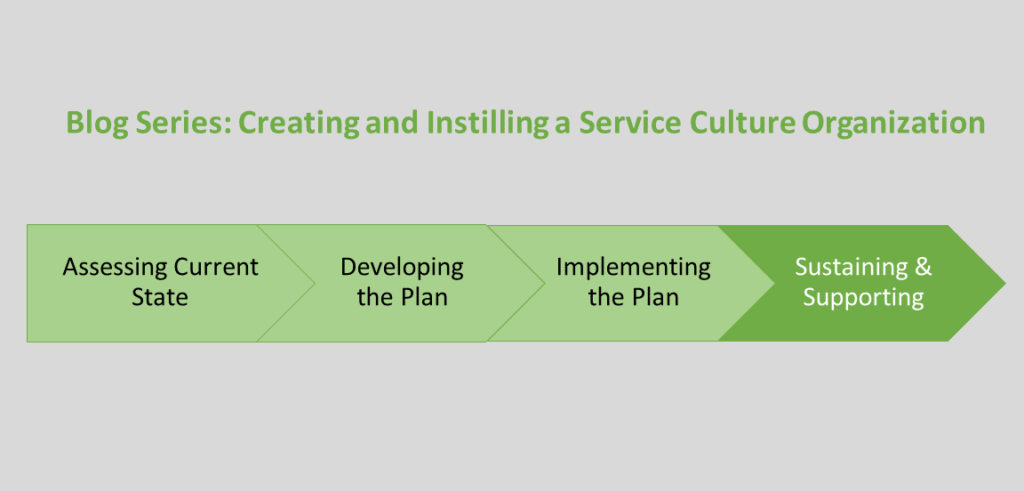
Organizations often believe that merely putting their staff through a training program about service will suffice for “fixing” their service culture. Training – in and of itself – is necessary, but insufficient. There are no “quick fixes” to help instill a culture of service throughout the organization. To complete this blog series we will discuss the final step, which is to take action to support your leaders and staff and sustain your service culture going forward.
Supportive Tool Kits
It is essential that you develop supporting materials for leaders and staff in order to keep the concepts alive from the training modules you develop. There has to be more than a (fill in your number)-hour training module on service to create or change a service culture in your organization. Some organizations we have had the pleasure of working with find themselves with more creative elements developed than will fit into their training modules. Fortunately these “leftovers” make great tool kits for ongoing support of the service culture. For one organization, we had extra patient, family, and staff vignettes so we mapped them against the various standards and created a multi-month video for the managers to use to kick off a huddle, staff meeting, or team discussion about that aspect of service.
Validation & Accountability
How do you know that your efforts are working? Patient experience scores are only one part of the equation to help measure your success. What is happening to your complaints? What do you patient comments look like? What feedback are you gaining from leader rounding that can inform your efforts? Often we will shadow leaders as they do their rounds and provide feedback for them. This helps leaders see ways to hold their team accountable and equip them to talk to their staff about accountability.
There are other metrics too: some organizations will incorporate care board audits to see how well the concepts and expectations are being carried out unit by unit. Other organizations will use a pre- and post- self-assessment for participants to help determine any impact of the change in the organization. Additionally, the Service-Driven culture survey that is administered at a leadership level can be repeated every 18 months to 2 years to assess changes within those levels of the organization.
Assess & Retool
As with every performance improvement effort, we need to evaluate and reassess the progress and incorporate any additional strategies as needed. Looking back at the planning and implementation phases, were there complicating factors that inhibited the realization of the gains you intended? We have worked with organizations as they went through changes in patient experience and/or senior leadership (in one case a new CEO) which may cause the best-laid plans to be re-thunk! Other organizations have decided to implement a new EMR in the midst of rolling out their service culture promotion. Any of these things can have an impact to the plan and the program and you will need to make adjustments.
Care Team Coaching
We have a whole series coming on Care Team Coaching so we won’t say too much about this here other than that it is SO important. It’s one thing to participate in some sort of education on service standards, service culture, AIDET, you name it. But it’s another thing entirely to have a personal coach give individual attention. Let’s face it: we all tend to think that we already do a pretty good job of these things so it’s helpful to have an external eye validate or challenge these assumptions.
Care Team Coaching is a tremendously personal way to help give people that feedback and assess exactly where they are with regard to the concepts have been taught in the various educational aspects of your program. Training coaches and selecting participants requires great skill and is something we have perfected over time. This can be a powerful tool and a very important part of your service culture efforts.
We love your weather but…
Any service culture effort ultimately needs to be owned from within. At DTA (coming from Minnesota) we often joke with our clients that we may “love your weather, but we don’t want to live here.” Each of us has family and a reason to call the great state of Minnesota home, despite those snowy March days when we wonder why! To us, the best indicator of success in any project is when we are able to achieve a smooth transition and handoff to internal leadership.
We see the hallmark of a great service culture program to be sustained and nurtured from the staff and leaders within. Our experience is that even after a successful transition, the highest performers are always striving for continued improvement. Thus our collective belief is that a robust service culture is definitely a journey more than a final destination.
“We want the patient experience to be surrounded by a culture of service throughout the healing process. We believe this is best served by having an organic personalized approach — created from within our own hearts and minds. DTA has helped us achieve that custom approach.”
—TOMI RYBA, PRESIDENT AND CEO, EL CAMINO HOSPITAL
